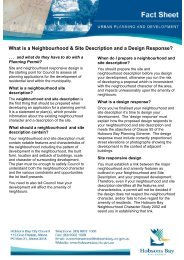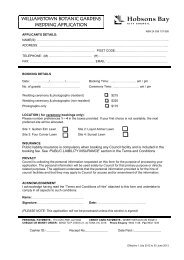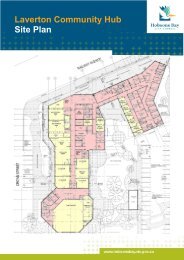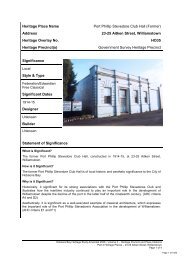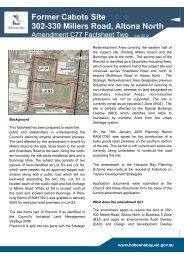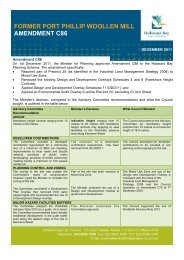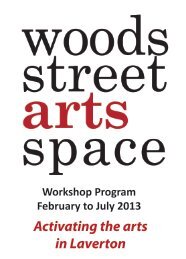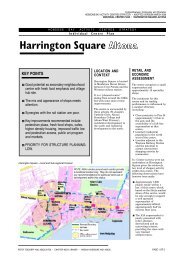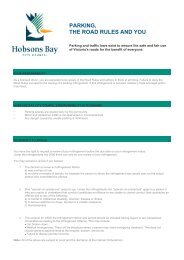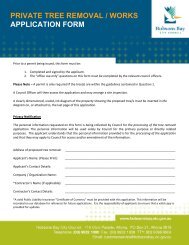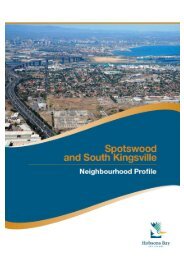Sustainable - Hobsons Bay
Sustainable - Hobsons Bay
Sustainable - Hobsons Bay
Create successful ePaper yourself
Turn your PDF publications into a flip-book with our unique Google optimized e-Paper software.
H O BSON S B AY FI VE YEA R SU ST AIN AB LE TO U R I S M S TRA TEG Y<br />
H O BSON S B AY FI VE YEA R SU ST AIN AB LE TO U R I S M S TRA TEG Y<br />
TTPoint Cook Coastal Park & Cheetham Wetlands Future Directions Plan. Parks Victoria. June 2005.T T<br />
SYNOPSIS &/OR KEY FINDINGS<br />
comprise a total area of 863 ha. In addition, the Point Cooke Marine<br />
Sanctuary, which adjoins Point Cook Coastal Park, is 290 ha.<br />
Point Cook Coastal Park is relatively well established & was created<br />
in 1978 to preserve the historic homestead & the nearby Basalt Plains<br />
Grasslands, freshwater lakes & coastal dune ecosystems. The Park<br />
was officially opened to the public in 1982.<br />
The parklands predominantly service residents living in the<br />
municipalities of <strong>Hobsons</strong> <strong>Bay</strong> & Wyndham, but also attracts visitors<br />
from across Melbourne & further afield.<br />
The parklands attract approximately 200,000 visitors per annum, but<br />
this figure is expected to rise as the population increases. Whilst the<br />
City of <strong>Hobsons</strong> <strong>Bay</strong> is expected to experience little to moderate<br />
population growth over the next 10-15 years, the City of Wyndham<br />
& the Point Cook area will experience significant population &<br />
residential growth.<br />
The Park & Wetlands include:<br />
The internationally significant Cheetham Wetlands, which was<br />
designated Ramsar status in recognition of its high value as habitat<br />
for water birds.<br />
Shore birds of international importance, including the Double<br />
banded Plover, Curlew, Red necked Stint, Sharp tailed Sandpiper<br />
& Pied Oystercatcher.<br />
Diverse vegetation types<br />
Sites of archaeological & cultural heritage significance to<br />
Indigenous communities.<br />
The Point Cook homestead precinct, including the historic<br />
homestead & landscape setting, which are of state significance.<br />
The Point Cooke Marine Sanctuary encompasses a number of<br />
habitats including sandy beaches, sub tidal soft sediment, intertidal<br />
& sub tidal reefs.<br />
A number of settings ranging from the Beach Picnic Area on the<br />
shores of Port Phillip <strong>Bay</strong> to the ephemeral (freshwater) wetlands<br />
of Spectacle Lake & Lignum Lake, & the RAAF Lake.<br />
Some of the key initiatives for the parklands, which will be the key<br />
focus over the next five years include:<br />
Construct Stage 2 of the <strong>Bay</strong> Trail & undertake planning for Stage<br />
3 of the trail adjacent to Cheetham Wetlands.<br />
Expand the internal trail network within Point Cook Coastal Park<br />
at Spectacle Lake, the RAAF Lake & the Duck Pond.<br />
Work with <strong>Hobsons</strong> <strong>Bay</strong> City Council to encourage coordinated<br />
management of open space & promote joint signage & educational<br />
programs.<br />
Develop Point Cook Coastal Park as a destination for school<br />
groups for marine education & interpretation.<br />
Parkland’s Visitors strategies inc.<br />
Utilise Parks Victoria’s Levels of Service framework to develop<br />
priorities for the parklands relating to:<br />
COMMENT<br />
Opportunities include<br />
Cooperative promotion of the<br />
above assets with Parks Victoria<br />
particularly focusing on off peak<br />
periods.<br />
The extension of the bike trail will<br />
be a major opportunity to promote<br />
the Park & the wider Council area<br />
to the large Melbourne leisure<br />
cycling market including family<br />
markets.<br />
Generate PR for <strong>Hobsons</strong> <strong>Bay</strong> off<br />
the back of the Ramsar status of the<br />
wetlands & the associated migratory<br />
birds story<br />
Continue to enhance interpretive<br />
signage in association with Parks<br />
Victoria.<br />
TTPoint Cook Coastal Park & Cheetham Wetlands Future Directions Plan. Parks Victoria. June 2005.T T<br />
SYNOPSIS &/OR KEY FINDINGS<br />
- Standards for facilities & services.<br />
- Range of recreational opportunities.<br />
- Coordination of visitor information.<br />
- Economically sustainable facilities &<br />
services.<br />
Review the information interpretation & education strategy for the<br />
parklands to promote the health & well-being benefits of parks &<br />
open space.<br />
Encourage activities through leases & licenses that are inclusive of<br />
parkland visitors & compatible with management zones.<br />
Ensure any future commercial arrangements within the Parklands<br />
are consistent with each management zone, complement the park<br />
values & diversifies visitor opportunities.<br />
Monitor visitor numbers to ensure the appropriate provision of<br />
low impact visitor facilities.<br />
Use orientation, information & interpretative information to<br />
inform visitors, adjoining & owners, new residents & the<br />
community on natural, marine & cultural heritage values. This<br />
should include flora & fauna, catchment hydrology, indigenous &<br />
non-indigenous cultural heritage & environmental management.<br />
Maintain the key visitor areas for passive recreational use &<br />
socialising & the minor visitor areas for low impact, nature based<br />
opportunities such as walking & bird watching.<br />
Monitor & ensure appropriate provision for possible increased<br />
demand for future recreation & leisure activities.<br />
Maintain existing dog, cat, horse & trail bike prohibition for the<br />
majority of the parklands to protect the values & work with<br />
<strong>Hobsons</strong> <strong>Bay</strong> & Wyndham City Councils to investigate<br />
coordinated signage & educational programs.<br />
Investigate potential areas within Conservation & Recreation, &<br />
Recreation zones, such as the paddock on Homestead Road, to be<br />
made available for dog access.<br />
Work with the Point Cook Cheetham Wetlands Advisory<br />
Committee & other stakeholders to determine appropriate dog<br />
access that does not compromise the natural values of the<br />
parklands.<br />
Review the current hire scheme for visitor sites at the Beach Picnic<br />
Area for large groups.<br />
Promote use of Point Cook Coastal Park by large groups through<br />
the week when there is substantial visitor capacity, as opposed to<br />
weekends when saturation levels are reached during the peak<br />
periods.<br />
Continue to provide ranger assistance to ensure disabled access to<br />
the homestead precinct, Beach Picnic Area & the Tower is<br />
maintained.<br />
TTTruganina Coastal Parklands Integrated Masterplan 2005. TT<br />
SYNOPSIS &/OR KEY<br />
FINDINGS<br />
Truganina Coastal Parklands is a<br />
COMMENT<br />
COMMENT<br />
Key tourism opportunities are the extension of the <strong>Bay</strong> Trail &<br />
FINAL DRAFT 1 AUGUST Page 70<br />
FINAL DRAFT 1 AUGUST Page 71<br />
68 69



